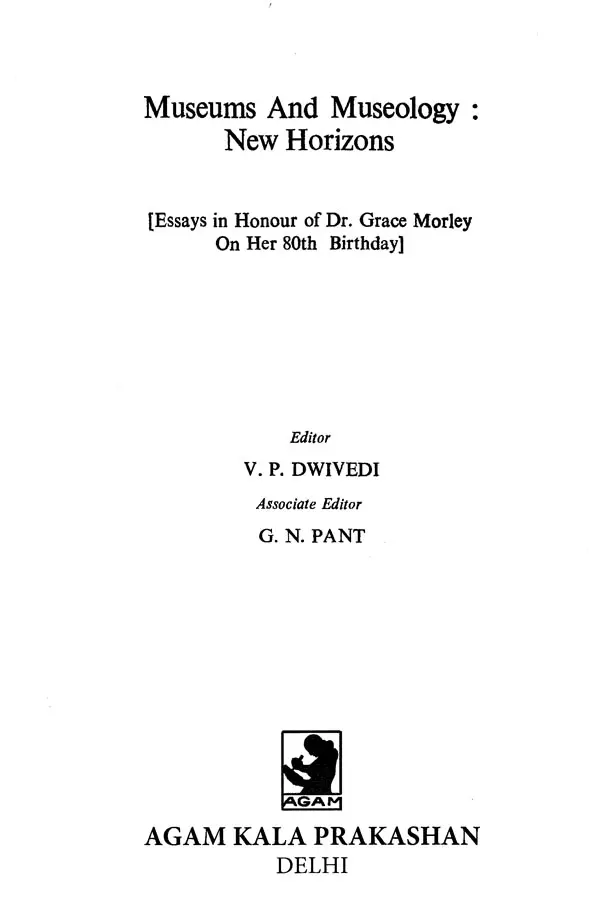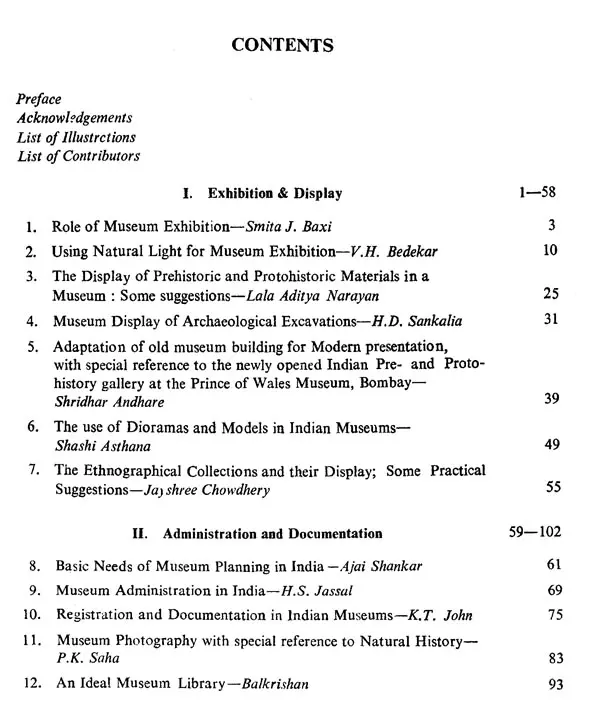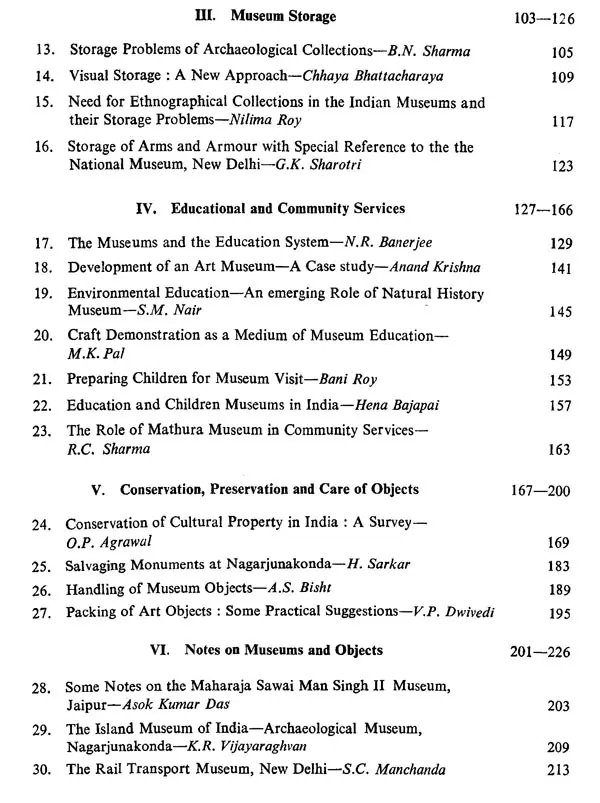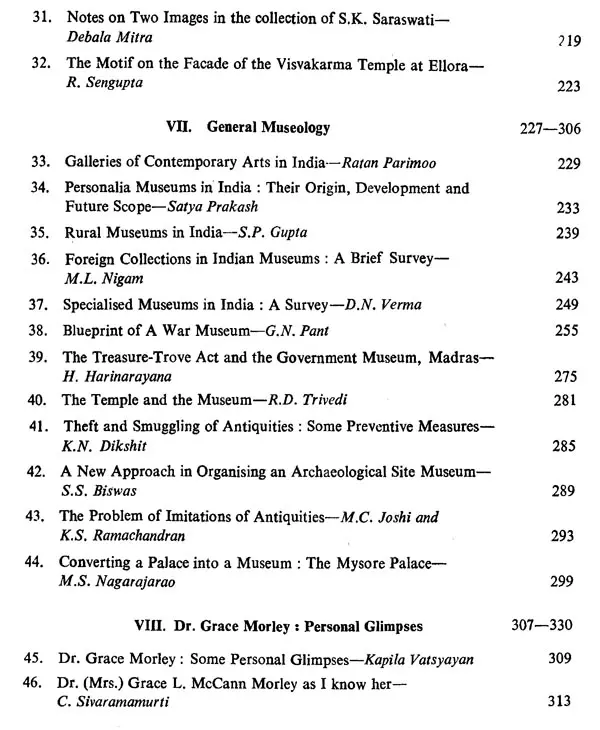
Museums and Museology: New Horizons (Essays in Honour of Dr. Grace Morley on Her 80th Birthday)
Book Specification
| Item Code: | UAM267 |
| Author: | V. P. Dwivedi |
| Publisher: | Agam Kala Prakashan, Delhi |
| Language: | English |
| Edition: | 2019 |
| ISBN: | 9788173201905 |
| Pages: | 428 (Throughout B/W Illustrations) |
| Cover: | HARDCOVER |
| Other Details | 11.50 X 8.50 inch |
| Weight | 1.44 kg |
Book Description
The advent of Dr. Grace Morley on the horizon of Indian museums in 1960 heralded a new era. For the past 19 years she has been untiringly serving the cause of museums in India and its neighbourhood. The book Museums and Museology: New Horizons is a humble token of her associates and admirers' reverence birthday. to her and is dedicated to her on the occasion of her 80th birthday
Her impact on almost every aspect of museology is well known. But the influence she exercised in the field of 'exhibition techniques' is the foremost. The methods which she introduced at the National Museum were oriented to Indian conditions and were widely followed putting Indian museums on international footings. For instance, the use of hessian or other hand woven rough-textured cloth as background material by her has widely been followed all over India, nay Asia. In Part I of the Book, devoted to this aspect of practical museology, some of her ex-colleagues and friends and some young museologists have tried to suggest ways and means to improve displays.
Those who know Dr. Morley from the days of her Directorship of the National Museum recall her devotion to the minute details, like a true museum person. She balanced her time well and gave equal importance to the administration and documentation and the gallery work. The Part II of the book, devoted to the Administration and Documentation, stresses the need of planning in museums, of proper documentation, including photography, and suggests how best to organise a museum library.
Dr. Morley was the first to realise the importance of proper storage in museums and gave new lease of life to the Central Asian Antiquities by arranging its storage methodically. The work started by her has continued and four of the Museums' storages have been discussed in Part III in the sincere hope that these 'case studies' will serve as model to other institutions.
The Part IV of the book deals with 'Educational and Community Services', whose cause has always been very dear to Dr. Morley. In fact, she was responsible for creating a full-fledged department of educational services at the National Museum. Now the role of museum as an educational institution is a well established fact and some museums have made their place in the local society because of their community services. However, in a country like India, where illiteracy is so rampant, museums can play their own role in solving the problem.
How dear the 'Conservation, Preservation and Care of Objects', which have been dealt in Part V of the book; have been to Dr. Morley can well be illustrated by an incident which occurred at the time of the exhibition arranged for the International Congress of Orientalists in 1964. One of our collagues was counting the leaves of a manuscript received on loan for the exhibition in the conventional way-by licking his fingers. As soon as she noticed it, she scolded the person and said that besides the fact that he was likely to fall ill, he could have damaged the already tattered manuscript. Then she herself demonstrated as to how to count the leaves of a manuscript gently with the help of both the hands. She also taught the dignity of handling the art objects ourselves and not to leave it to an attendant. How to transport the objects from one part of the museum to another-wrapped in tissue papers and kept in cotton padded trays or on trollies; was also lovingly taught by her.
Dr. Morley's jurisdiction was never confined to the National Museum and she has always been more than willing to help other institutions. Part VI of the book acquaints us with some of the outstanding museums and art objects.
There is hardly any aspect of museology which did not get the golden touch of Dr. Morley. She has been known as "Mataji" (Mother) in the Indian Museum World. She inspired people to write and encouraged them to speak in public and conduct seminars and conferences. The 'Museum Camps' started by her, still remain a very good forum for museum people to exchange ideas. Part VII of the book provides close-ups of different aspects of museums and museology.
In the last part of the book, Part VIII, we get glimpses of Dr. Morley's magnanimity through the pens of such authorities who had the opportunity to work very closely with her. Some of the rare photographs show her with eminent national leaders. The Bibliography of her writings at the end of the book gives a true picture of Dr. Morley's contribution to practically all aspects of museology.
This bunch of articles by persons who had been either associated with her or have been benefited by her wisdom, directly or indirectly, in the form of 'Sraddha Suman', is dedicated to her on the occasion of her 80th birthday with the prayer that she continues to be the guiding spirit of the museums in India and abroad for many more decades to come.






















